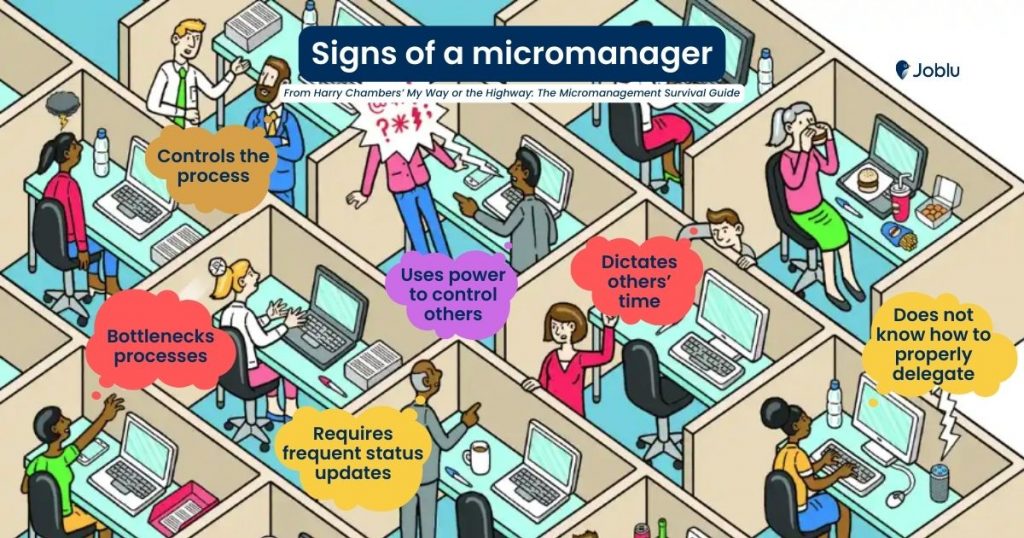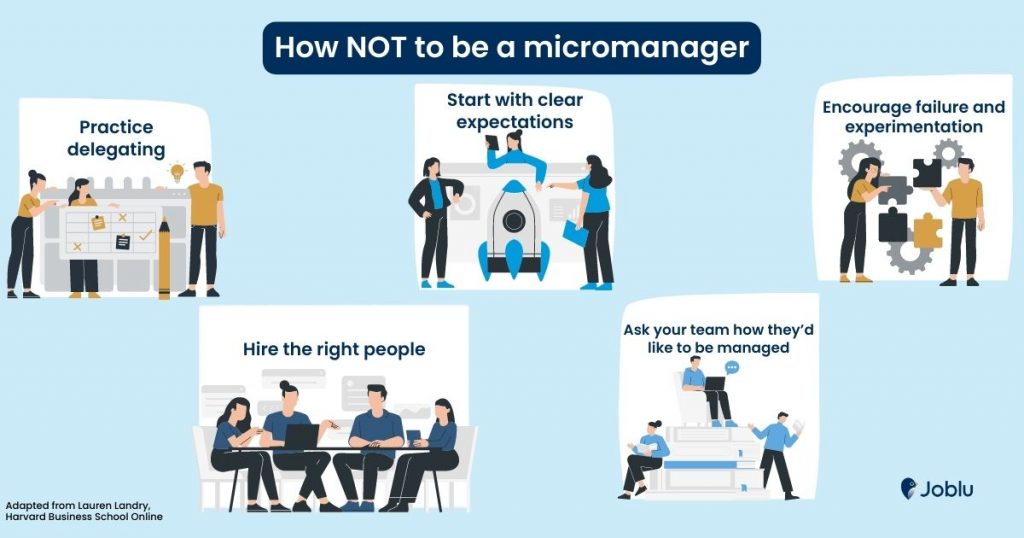Employee engagement has been on a downward spiral in the last two years. According to a Gallup research in the US, the numbers have been going down since 2020, from 36% down to 32% in 2022. Different factors can cause disengagement among employees, with many that boil down to one common sentiment. Workers feel that their workplaces do not care for their needs. This is most evident in workplaces that allow a micromanagement leadership style to prevail.
If you’ve noticed teams or workers with low morale or productivity, it might be time to check on them. Get their feedback on management and see if there’s a micromanager in your midst. In this guide, you’ll learn about what micromanagement is, its telltale signs, and its effects on teams. You’ll also get tips on how to avoid micromanagement to create a healthier work environment.
What is Micromanagement?
Micromanagement is a leadership style where a manager controls employees extremely and practices excessive supervision, showing no trust in his team. In a nutshell, it’s the equivalent of someone breathing down your neck as you’re trying to do your work, both literally and figuratively.
While not always the case, micromanagers are typically high-performing workers who were promoted based on their performance only. This means they’re used to working hard and controlling their individual output. Now in a leadership role, they seek to get identical results from their members. But instead of believing in the skills of their colleagues, a micromanager believes only in using their own methods. This may stem from a lack of confidence and trust in others, as well as a fear of failure. Most micromanagers will not know the difference between coaching and micromanaging due to a lack of management and leadership training.
6 Signs That a Boss is a Micromanager

Every employee, it seems, has had an experience with a micromanager. In a Trinity Solutions survey, as published in Harry Chambers’ My Way or the Highway: The Micromanagement Survival Guide, 79% of employees have experienced micromanagement, with 85% saying that micromanagement has affected their morale. Up to 69% considered resigning because of the bad management style, with 36% actually resigning.
So if you’re not sure if you’ve just promoted a micromanager, here are a few signs to look out for, according to Chambers:
1. Dictates others’ time
A micromanager may constantly call for all types of emergency meetings. They also impose on their team’s schedules, constantly being in charge of how they spend their time.
2. Controls the process
A micromanager prefers to do things their way, disregarding team members’ areas of expertise and input. This may stem from either a fear of failure or a refusal to move out of one’s comfort zone.
3. Uses power to control others
A micromanager may inadvertently pull the ‘manager’ card to get their way. They do this by referencing the workplace hierarchy and by answering “Why?” with “Because I said so.” Micromanagers do these to discourage the team from raising their concerns. They consider questioning from employees as a threat to their authority, a sign that they don’t have their team under control.
4. Requires frequent status updates
A micromanager often requires frequent and unnecessary status updates on every minutiae of a project. They may not have ill intent when asking for constant status updates. However, this behavior can make employees feel like they’re being monitored because they can’t be trusted to work on their own.
5. Bottlenecks processes
This is an even more disruptive version of a micromanager needing constant updates on projects. A micromanager will want to sign off or feel the need to approve every step of a process, effectively stalling the progress of a project.
6. Does not know how to delegate properly
Because of a micromanager’s need for control, they will have a hard time delegating. They may delegate only when it’s already absolutely necessary.
The Effects of Micromanagement
Ron Friedman, psychologist, and behavioral change expert says “Micromanagement is the motivational equivalent of buying on credit. Enjoy a better product now, but pay a hefty price later.” While micromanagers are good at producing short-term results, they’re achieving them at the cost of their team’s overall well-being and the company itself. Below are a few of the effects micromanagement may have on your employees and on your business:
Lowers employee morale and self-confidence
When they monitor every move, a micromanager can destroy an employee’s self-confidence. Such close monitoring sends the signal that a manager does not believe in the employee’s ability to do their job properly.
Discourages creativity and breeds passivity
By always dictating how tasks should be done on every minute level, a micromanager may inadvertently cause employees to take a more passive role in the workplace. This can stunt their professional growth as simply taking orders will prevent them from demonstrating and growing their skills.
Destroys teamwork
Because of the lack of delegation, a micromanaged team will not collaborate with each other to get things done. Instead, each team member only works directly with the micromanager, effectively destroying the essence of working within a team.
Causes mistrust among employees and management
Micromanagement sends a signal to employees: your manager does not trust you to do your job well. When an employee feels this, they take on the same feeling of mistrust towards the rest of management.
Instigates higher staff turnover
The effects of micromanagement do not just stay within a team; they can bleed over to the rest of the organization. Micromanaged team members will burn out faster and be more fearful of losing their jobs or being demoted, and so instead of seeing these fears manifest, they resign.
Causes mental health issues
At its worst, micromanagement can feel like bullying. It can manifest a whole host of mental health concerns. Many employees who have undergone micromanagement report experiencing lack of motivation, fatigue, sleep problems, increased stress, depression, and anxiety.
How NOT to be a Micromanager

There are proactive ways for a manager to avoid micromanagement and develop a healthier work environment. Here are a few tips from Lauren Landry, the director of marketing and communications for Harvard Business School Online.
1. Practice delegating
Delegating means assigning tasks to team members based on their roles, strengths, and potentials. By delegating, a manager will let go of some form of control over the minutiae of the project, focusing instead on the big picture and providing the right resources and motivation for the entire team to finish a project and get the desired result.
2. Start with clear expectations
Start every project with clear expectations in mind: objectives, deadlines and metrics for success. Then trust every team member to prove their mettle by contributing to the mission in their own ways, using their skills and intelligence to achieve a common goal.
3. Encourage failure and experimentation
Micromanagers seek control because they fear failure. They seek to stay within their comfort zones and force the team to do the same. To avoid this, normalize failure in your team as a way to grow and develop. Encourage new ideas, take time to test them, and if a method fails, don’t censure the result and instead learn from the experience.
4. Hire the right people
Hiring the right people will make it easier for managers to avoid micromanaging. It’s easier to default to micromanagement when you can sense an employee is under-qualified or a bad fit for a position.
5. Ask your team how they’d like to be managed
Every team member may have a different leadership style preference. When in doubt, just ask. Others may not thrive being constantly monitored, while there are others who need a bit of coaching every step of the way.
4 steps to address micromanagement when it’s happening
If you receive a report that one of your supervisors or middle managers is a micromanager, don’t brush it off. Here’s a step-by-step guide to address the issue openly in the workplace:
1. Open up a dialogue
To address the issue, it’s essential to mediate a dialogue between both parties in a polite, sensitive, and professional manner. In this meeting (or sets of meetings if needed), the following should be discussed:
- Specific instances of micromanagement
- Perceived effects of micromanagement
- Manager’s reasons for resorting to micromanagement
- Re-stating job expectations, roles, delegated tasks
2. Agree on a new monitoring style
After the dialogue, the team should then work together to come up with a new monitoring style. The new style should include when team members are required to send reports, and how to measure performance.
3. Encourage an open-door policy
Instead of breathing down their team members’ necks, encourage the leader to adopt an open-door policy. This is for members who feel the need for coaching or extra support. It’s up to them to initiate whether they need their manager’s help or intervention.
4. Check in for improvements
One meeting will not solve an ongoing issue, especially if it’s one that’s been happening for a while. Check in on your team and manager at regular intervals and get their feedback on their improved process, and see what’s working and what’s not.
Micromanagement might be an effective stop-gap solution but its long-term effects can be detrimental. Not only is it bad for the productivity of any business, it can also negatively affect people’s mental health, which may be harder to resolve in the long run.
If you’re noticing a high turnover rate and low productivity in your workplace, it’s time to ask yourself and the leaders in your organization, what are the qualities of a good workplace? Then ask your teams if they find these qualities in your company. Be open to feedback then make proactive moves to prevent micromanagement habits. Provide support and training to your managers so they can lead your teams to success with grace and professionalism.
Building your team from the ground up or filling the roles for your most crucial leadership positions? Find your team’s future superstars from all parts of the world by downloading the Joblu app.